Learning Styles and Training Needs in Human Resource Management at McDonald's
VerifiedAdded on 2023/04/07
|13
|3715
|491
AI Summary
This report analyzes the learning styles used by McDonald's in human resource management and the role of the learning curve in measuring employee performance. It compares the training needs for different roles and discusses the advantages and disadvantages of different training methods. The report also explores techniques for evaluating training programs and reviews the success of evaluation methods. Get expert study material on HRM at Desklib.
Contribute Materials
Your contribution can guide someone’s learning journey. Share your
documents today.
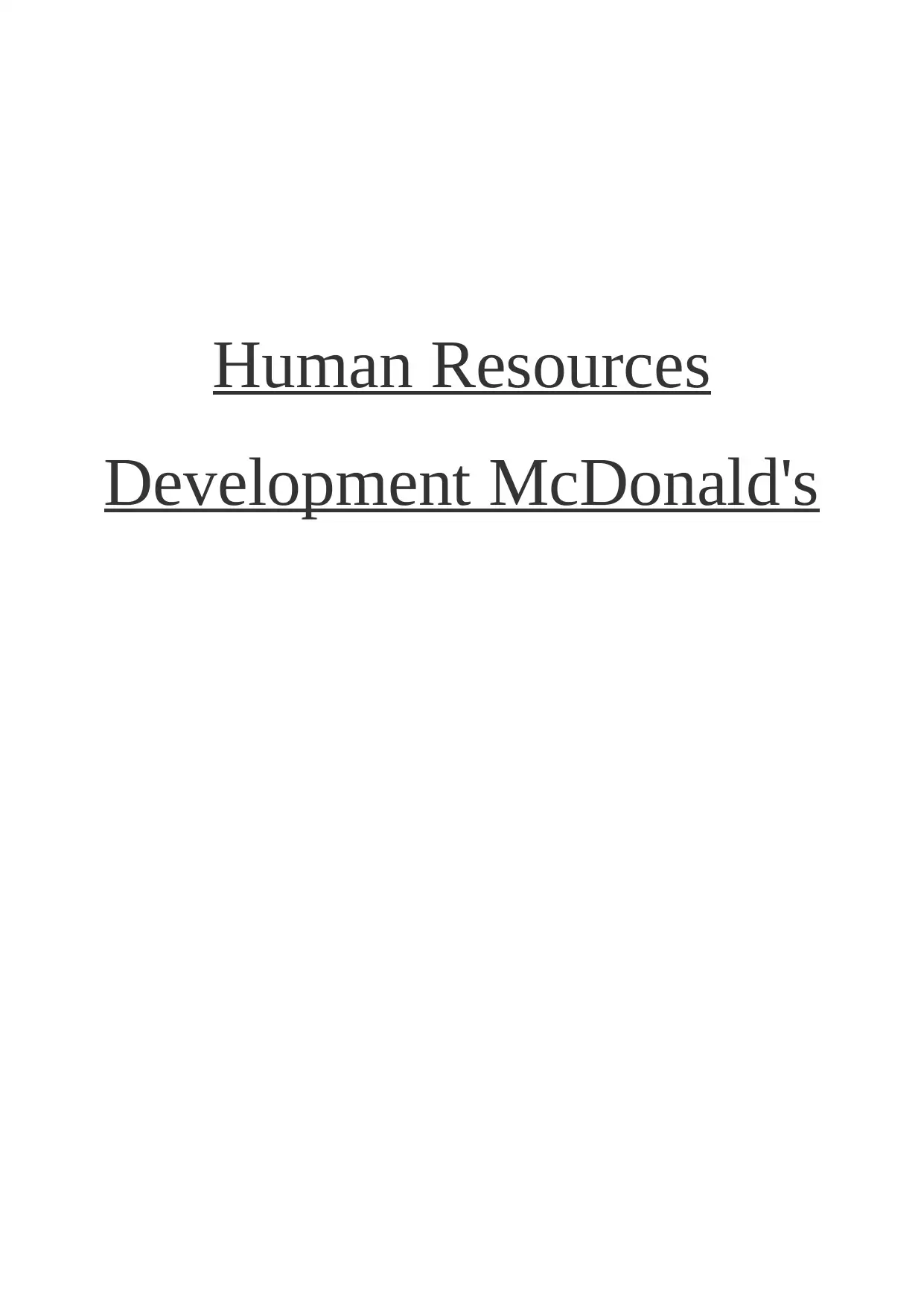
Human Resources
Development McDonald's
Development McDonald's
Secure Best Marks with AI Grader
Need help grading? Try our AI Grader for instant feedback on your assignments.
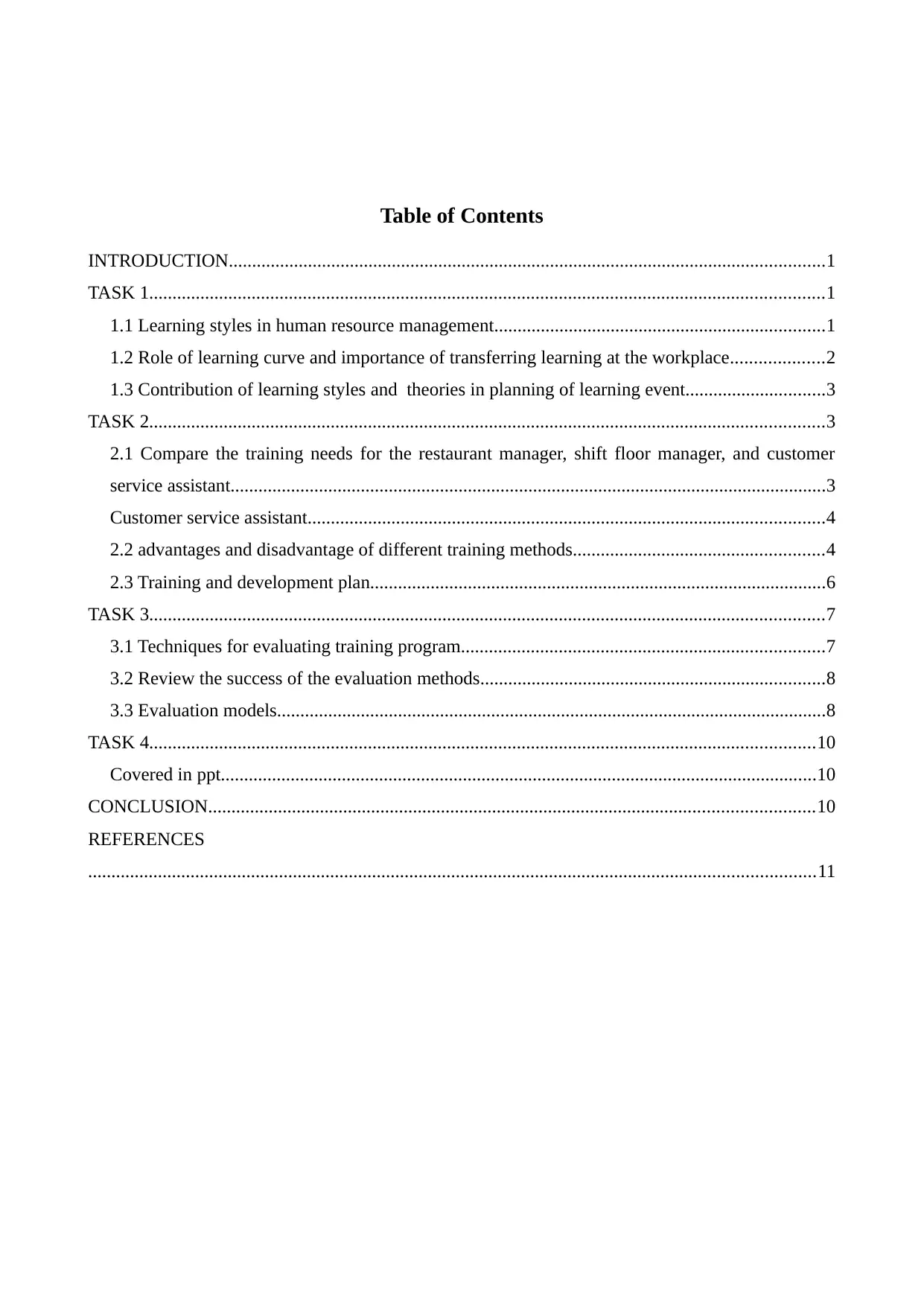
Table of Contents
INTRODUCTION................................................................................................................................1
TASK 1.................................................................................................................................................1
1.1 Learning styles in human resource management.......................................................................1
1.2 Role of learning curve and importance of transferring learning at the workplace....................2
1.3 Contribution of learning styles and theories in planning of learning event..............................3
TASK 2.................................................................................................................................................3
2.1 Compare the training needs for the restaurant manager, shift floor manager, and customer
service assistant................................................................................................................................3
Customer service assistant...............................................................................................................4
2.2 advantages and disadvantage of different training methods......................................................4
2.3 Training and development plan..................................................................................................6
TASK 3.................................................................................................................................................7
3.1 Techniques for evaluating training program..............................................................................7
3.2 Review the success of the evaluation methods..........................................................................8
3.3 Evaluation models......................................................................................................................8
TASK 4...............................................................................................................................................10
Covered in ppt................................................................................................................................10
CONCLUSION..................................................................................................................................10
REFERENCES
............................................................................................................................................................11
INTRODUCTION................................................................................................................................1
TASK 1.................................................................................................................................................1
1.1 Learning styles in human resource management.......................................................................1
1.2 Role of learning curve and importance of transferring learning at the workplace....................2
1.3 Contribution of learning styles and theories in planning of learning event..............................3
TASK 2.................................................................................................................................................3
2.1 Compare the training needs for the restaurant manager, shift floor manager, and customer
service assistant................................................................................................................................3
Customer service assistant...............................................................................................................4
2.2 advantages and disadvantage of different training methods......................................................4
2.3 Training and development plan..................................................................................................6
TASK 3.................................................................................................................................................7
3.1 Techniques for evaluating training program..............................................................................7
3.2 Review the success of the evaluation methods..........................................................................8
3.3 Evaluation models......................................................................................................................8
TASK 4...............................................................................................................................................10
Covered in ppt................................................................................................................................10
CONCLUSION..................................................................................................................................10
REFERENCES
............................................................................................................................................................11
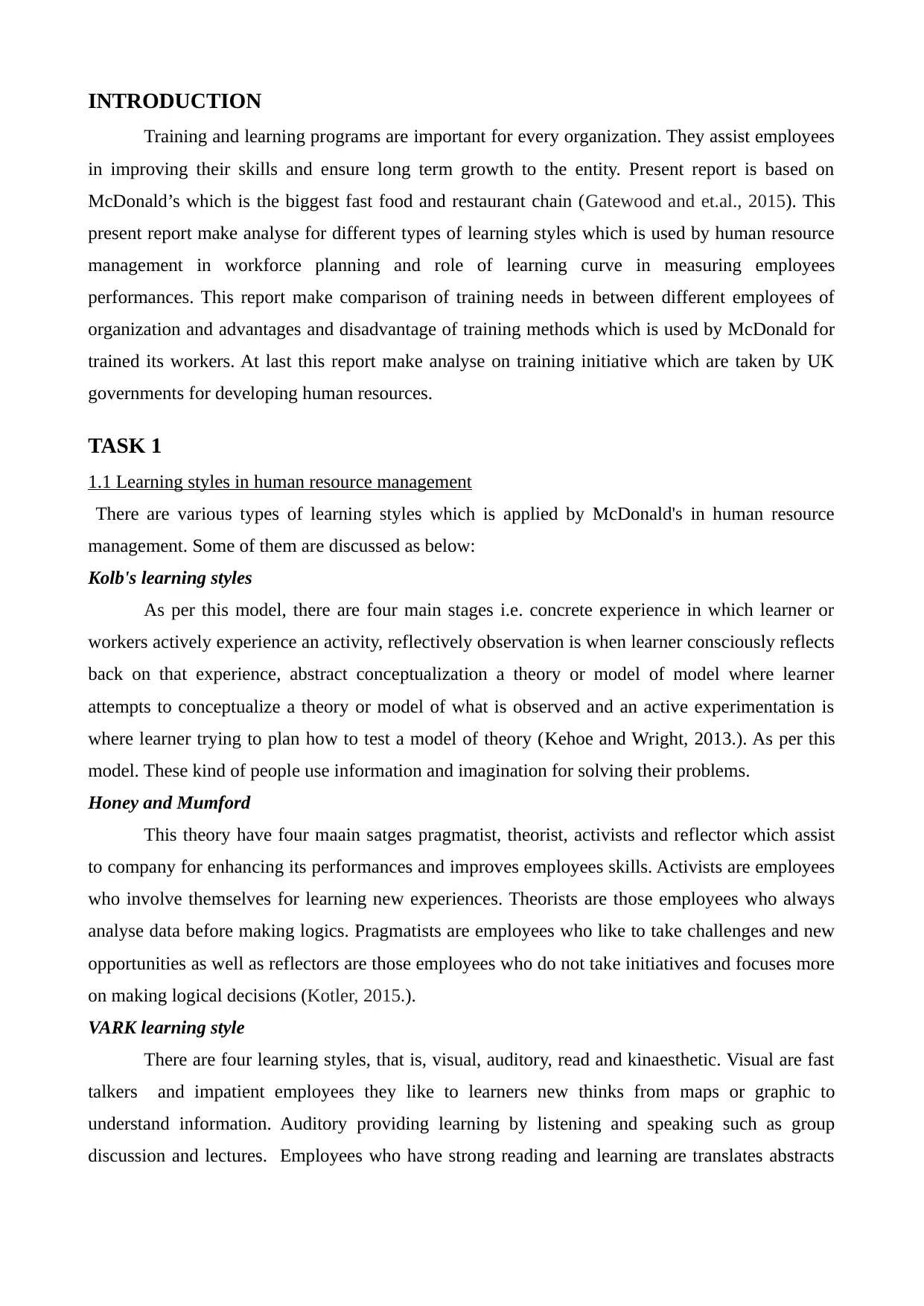
INTRODUCTION
Training and learning programs are important for every organization. They assist employees
in improving their skills and ensure long term growth to the entity. Present report is based on
McDonald’s which is the biggest fast food and restaurant chain (Gatewood and et.al., 2015). This
present report make analyse for different types of learning styles which is used by human resource
management in workforce planning and role of learning curve in measuring employees
performances. This report make comparison of training needs in between different employees of
organization and advantages and disadvantage of training methods which is used by McDonald for
trained its workers. At last this report make analyse on training initiative which are taken by UK
governments for developing human resources.
TASK 1
1.1 Learning styles in human resource management
There are various types of learning styles which is applied by McDonald's in human resource
management. Some of them are discussed as below:
Kolb's learning styles
As per this model, there are four main stages i.e. concrete experience in which learner or
workers actively experience an activity, reflectively observation is when learner consciously reflects
back on that experience, abstract conceptualization a theory or model of model where learner
attempts to conceptualize a theory or model of what is observed and an active experimentation is
where learner trying to plan how to test a model of theory (Kehoe and Wright, 2013.). As per this
model. These kind of people use information and imagination for solving their problems.
Honey and Mumford
This theory have four maain satges pragmatist, theorist, activists and reflector which assist
to company for enhancing its performances and improves employees skills. Activists are employees
who involve themselves for learning new experiences. Theorists are those employees who always
analyse data before making logics. Pragmatists are employees who like to take challenges and new
opportunities as well as reflectors are those employees who do not take initiatives and focuses more
on making logical decisions (Kotler, 2015.).
VARK learning style
There are four learning styles, that is, visual, auditory, read and kinaesthetic. Visual are fast
talkers and impatient employees they like to learners new thinks from maps or graphic to
understand information. Auditory providing learning by listening and speaking such as group
discussion and lectures. Employees who have strong reading and learning are translates abstracts
Training and learning programs are important for every organization. They assist employees
in improving their skills and ensure long term growth to the entity. Present report is based on
McDonald’s which is the biggest fast food and restaurant chain (Gatewood and et.al., 2015). This
present report make analyse for different types of learning styles which is used by human resource
management in workforce planning and role of learning curve in measuring employees
performances. This report make comparison of training needs in between different employees of
organization and advantages and disadvantage of training methods which is used by McDonald for
trained its workers. At last this report make analyse on training initiative which are taken by UK
governments for developing human resources.
TASK 1
1.1 Learning styles in human resource management
There are various types of learning styles which is applied by McDonald's in human resource
management. Some of them are discussed as below:
Kolb's learning styles
As per this model, there are four main stages i.e. concrete experience in which learner or
workers actively experience an activity, reflectively observation is when learner consciously reflects
back on that experience, abstract conceptualization a theory or model of model where learner
attempts to conceptualize a theory or model of what is observed and an active experimentation is
where learner trying to plan how to test a model of theory (Kehoe and Wright, 2013.). As per this
model. These kind of people use information and imagination for solving their problems.
Honey and Mumford
This theory have four maain satges pragmatist, theorist, activists and reflector which assist
to company for enhancing its performances and improves employees skills. Activists are employees
who involve themselves for learning new experiences. Theorists are those employees who always
analyse data before making logics. Pragmatists are employees who like to take challenges and new
opportunities as well as reflectors are those employees who do not take initiatives and focuses more
on making logical decisions (Kotler, 2015.).
VARK learning style
There are four learning styles, that is, visual, auditory, read and kinaesthetic. Visual are fast
talkers and impatient employees they like to learners new thinks from maps or graphic to
understand information. Auditory providing learning by listening and speaking such as group
discussion and lectures. Employees who have strong reading and learning are translates abstracts
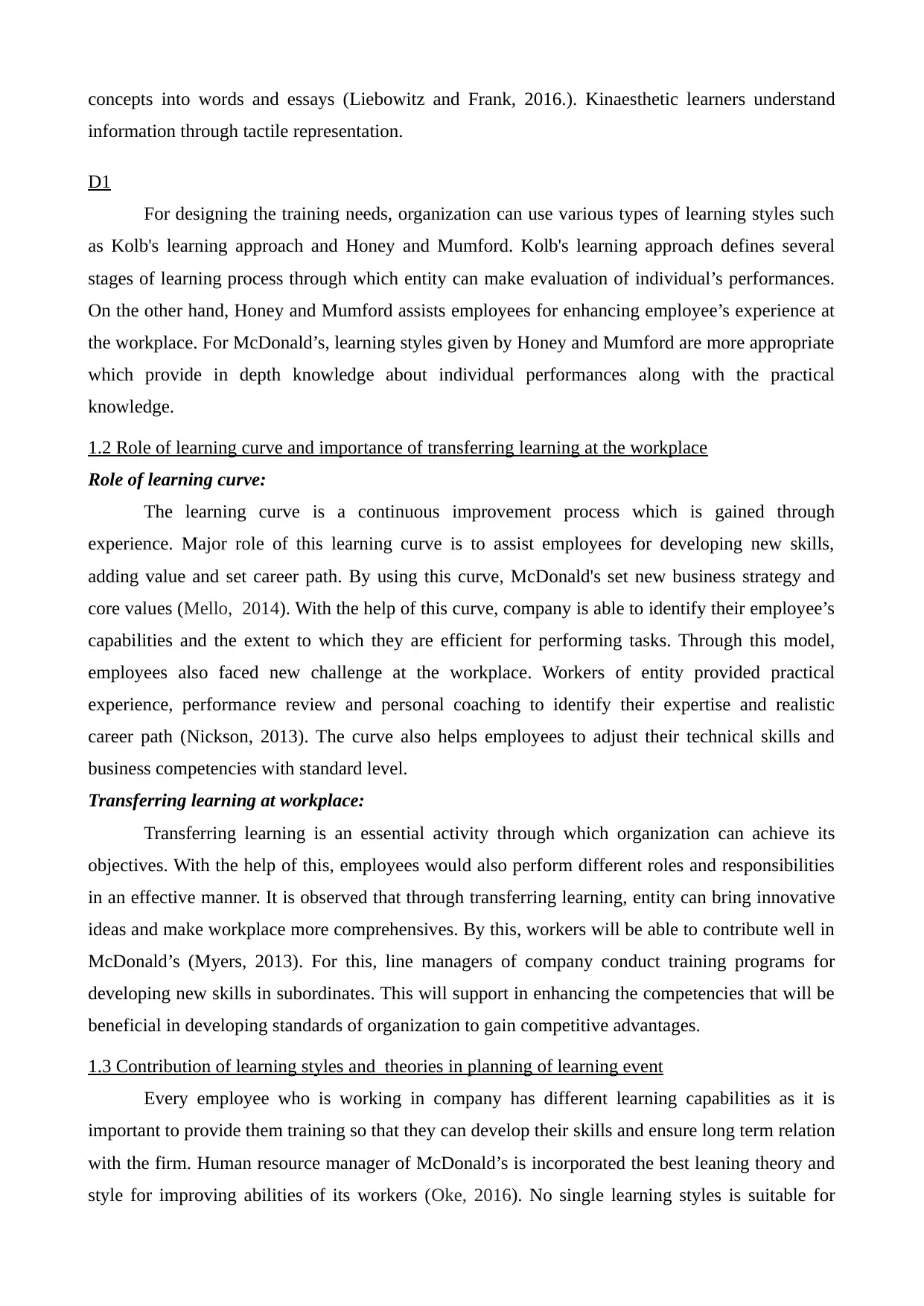
concepts into words and essays (Liebowitz and Frank, 2016.). Kinaesthetic learners understand
information through tactile representation.
D1
For designing the training needs, organization can use various types of learning styles such
as Kolb's learning approach and Honey and Mumford. Kolb's learning approach defines several
stages of learning process through which entity can make evaluation of individual’s performances.
On the other hand, Honey and Mumford assists employees for enhancing employee’s experience at
the workplace. For McDonald’s, learning styles given by Honey and Mumford are more appropriate
which provide in depth knowledge about individual performances along with the practical
knowledge.
1.2 Role of learning curve and importance of transferring learning at the workplace
Role of learning curve:
The learning curve is a continuous improvement process which is gained through
experience. Major role of this learning curve is to assist employees for developing new skills,
adding value and set career path. By using this curve, McDonald's set new business strategy and
core values (Mello, 2014). With the help of this curve, company is able to identify their employee’s
capabilities and the extent to which they are efficient for performing tasks. Through this model,
employees also faced new challenge at the workplace. Workers of entity provided practical
experience, performance review and personal coaching to identify their expertise and realistic
career path (Nickson, 2013). The curve also helps employees to adjust their technical skills and
business competencies with standard level.
Transferring learning at workplace:
Transferring learning is an essential activity through which organization can achieve its
objectives. With the help of this, employees would also perform different roles and responsibilities
in an effective manner. It is observed that through transferring learning, entity can bring innovative
ideas and make workplace more comprehensives. By this, workers will be able to contribute well in
McDonald’s (Myers, 2013). For this, line managers of company conduct training programs for
developing new skills in subordinates. This will support in enhancing the competencies that will be
beneficial in developing standards of organization to gain competitive advantages.
1.3 Contribution of learning styles and theories in planning of learning event
Every employee who is working in company has different learning capabilities as it is
important to provide them training so that they can develop their skills and ensure long term relation
with the firm. Human resource manager of McDonald’s is incorporated the best leaning theory and
style for improving abilities of its workers (Oke, 2016). No single learning styles is suitable for
information through tactile representation.
D1
For designing the training needs, organization can use various types of learning styles such
as Kolb's learning approach and Honey and Mumford. Kolb's learning approach defines several
stages of learning process through which entity can make evaluation of individual’s performances.
On the other hand, Honey and Mumford assists employees for enhancing employee’s experience at
the workplace. For McDonald’s, learning styles given by Honey and Mumford are more appropriate
which provide in depth knowledge about individual performances along with the practical
knowledge.
1.2 Role of learning curve and importance of transferring learning at the workplace
Role of learning curve:
The learning curve is a continuous improvement process which is gained through
experience. Major role of this learning curve is to assist employees for developing new skills,
adding value and set career path. By using this curve, McDonald's set new business strategy and
core values (Mello, 2014). With the help of this curve, company is able to identify their employee’s
capabilities and the extent to which they are efficient for performing tasks. Through this model,
employees also faced new challenge at the workplace. Workers of entity provided practical
experience, performance review and personal coaching to identify their expertise and realistic
career path (Nickson, 2013). The curve also helps employees to adjust their technical skills and
business competencies with standard level.
Transferring learning at workplace:
Transferring learning is an essential activity through which organization can achieve its
objectives. With the help of this, employees would also perform different roles and responsibilities
in an effective manner. It is observed that through transferring learning, entity can bring innovative
ideas and make workplace more comprehensives. By this, workers will be able to contribute well in
McDonald’s (Myers, 2013). For this, line managers of company conduct training programs for
developing new skills in subordinates. This will support in enhancing the competencies that will be
beneficial in developing standards of organization to gain competitive advantages.
1.3 Contribution of learning styles and theories in planning of learning event
Every employee who is working in company has different learning capabilities as it is
important to provide them training so that they can develop their skills and ensure long term relation
with the firm. Human resource manager of McDonald’s is incorporated the best leaning theory and
style for improving abilities of its workers (Oke, 2016). No single learning styles is suitable for
Secure Best Marks with AI Grader
Need help grading? Try our AI Grader for instant feedback on your assignments.
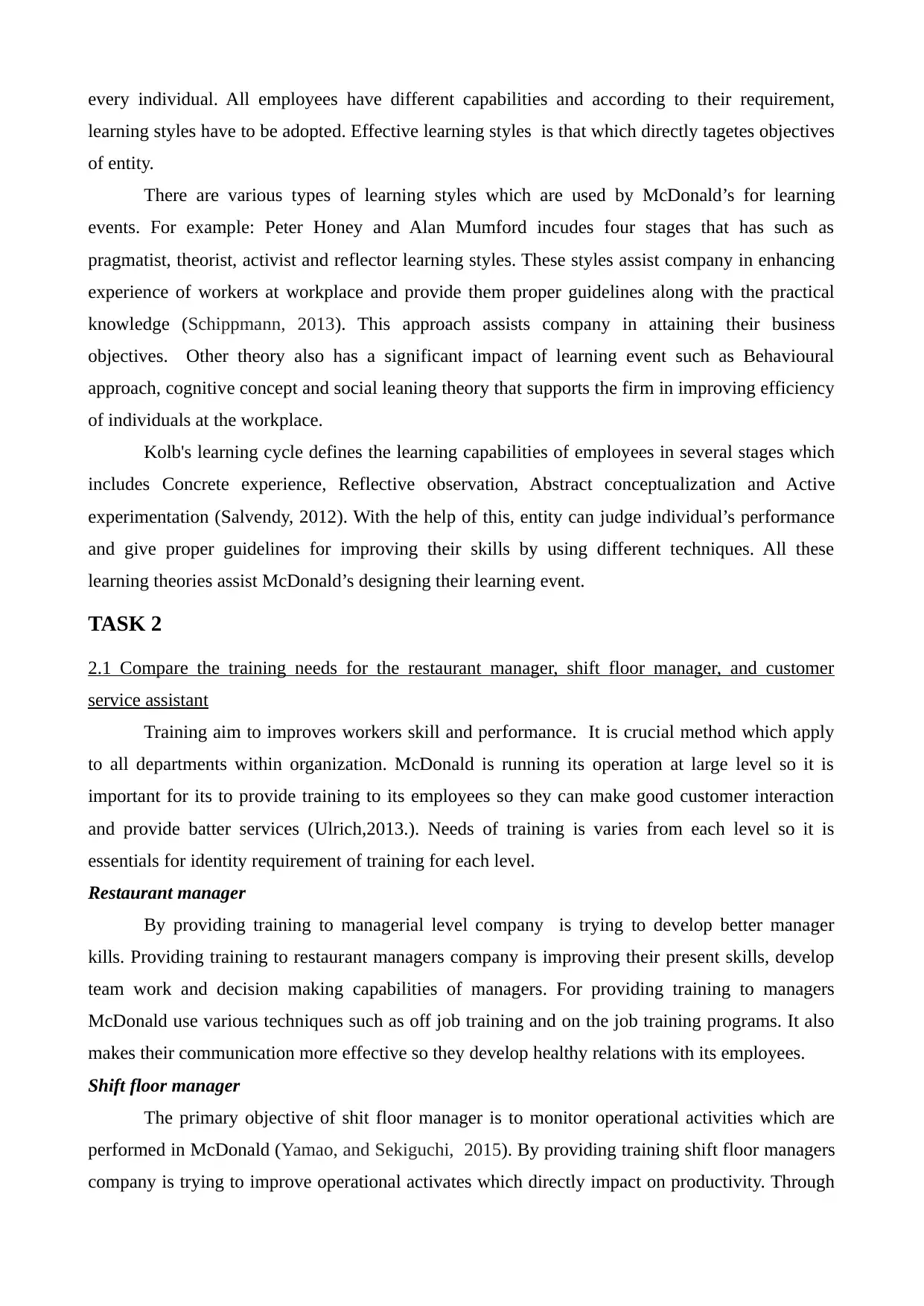
every individual. All employees have different capabilities and according to their requirement,
learning styles have to be adopted. Effective learning styles is that which directly tagetes objectives
of entity.
There are various types of learning styles which are used by McDonald’s for learning
events. For example: Peter Honey and Alan Mumford incudes four stages that has such as
pragmatist, theorist, activist and reflector learning styles. These styles assist company in enhancing
experience of workers at workplace and provide them proper guidelines along with the practical
knowledge (Schippmann, 2013). This approach assists company in attaining their business
objectives. Other theory also has a significant impact of learning event such as Behavioural
approach, cognitive concept and social leaning theory that supports the firm in improving efficiency
of individuals at the workplace.
Kolb's learning cycle defines the learning capabilities of employees in several stages which
includes Concrete experience, Reflective observation, Abstract conceptualization and Active
experimentation (Salvendy, 2012). With the help of this, entity can judge individual’s performance
and give proper guidelines for improving their skills by using different techniques. All these
learning theories assist McDonald’s designing their learning event.
TASK 2
2.1 Compare the training needs for the restaurant manager, shift floor manager, and customer
service assistant
Training aim to improves workers skill and performance. It is crucial method which apply
to all departments within organization. McDonald is running its operation at large level so it is
important for its to provide training to its employees so they can make good customer interaction
and provide batter services (Ulrich,2013.). Needs of training is varies from each level so it is
essentials for identity requirement of training for each level.
Restaurant manager
By providing training to managerial level company is trying to develop better manager
kills. Providing training to restaurant managers company is improving their present skills, develop
team work and decision making capabilities of managers. For providing training to managers
McDonald use various techniques such as off job training and on the job training programs. It also
makes their communication more effective so they develop healthy relations with its employees.
Shift floor manager
The primary objective of shit floor manager is to monitor operational activities which are
performed in McDonald (Yamao, and Sekiguchi, 2015). By providing training shift floor managers
company is trying to improve operational activates which directly impact on productivity. Through
learning styles have to be adopted. Effective learning styles is that which directly tagetes objectives
of entity.
There are various types of learning styles which are used by McDonald’s for learning
events. For example: Peter Honey and Alan Mumford incudes four stages that has such as
pragmatist, theorist, activist and reflector learning styles. These styles assist company in enhancing
experience of workers at workplace and provide them proper guidelines along with the practical
knowledge (Schippmann, 2013). This approach assists company in attaining their business
objectives. Other theory also has a significant impact of learning event such as Behavioural
approach, cognitive concept and social leaning theory that supports the firm in improving efficiency
of individuals at the workplace.
Kolb's learning cycle defines the learning capabilities of employees in several stages which
includes Concrete experience, Reflective observation, Abstract conceptualization and Active
experimentation (Salvendy, 2012). With the help of this, entity can judge individual’s performance
and give proper guidelines for improving their skills by using different techniques. All these
learning theories assist McDonald’s designing their learning event.
TASK 2
2.1 Compare the training needs for the restaurant manager, shift floor manager, and customer
service assistant
Training aim to improves workers skill and performance. It is crucial method which apply
to all departments within organization. McDonald is running its operation at large level so it is
important for its to provide training to its employees so they can make good customer interaction
and provide batter services (Ulrich,2013.). Needs of training is varies from each level so it is
essentials for identity requirement of training for each level.
Restaurant manager
By providing training to managerial level company is trying to develop better manager
kills. Providing training to restaurant managers company is improving their present skills, develop
team work and decision making capabilities of managers. For providing training to managers
McDonald use various techniques such as off job training and on the job training programs. It also
makes their communication more effective so they develop healthy relations with its employees.
Shift floor manager
The primary objective of shit floor manager is to monitor operational activities which are
performed in McDonald (Yamao, and Sekiguchi, 2015). By providing training shift floor managers
company is trying to improve operational activates which directly impact on productivity. Through
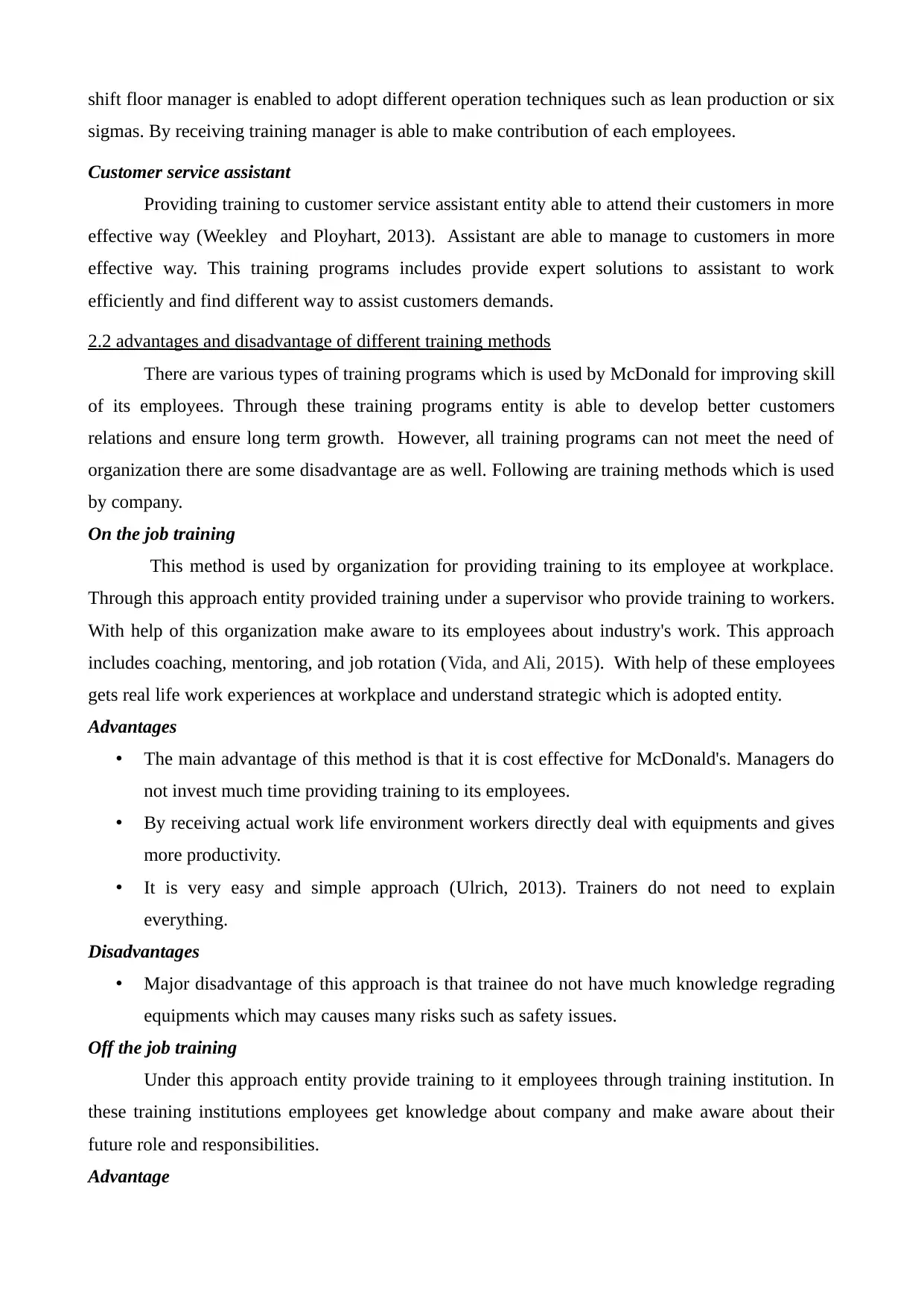
shift floor manager is enabled to adopt different operation techniques such as lean production or six
sigmas. By receiving training manager is able to make contribution of each employees.
Customer service assistant
Providing training to customer service assistant entity able to attend their customers in more
effective way (Weekley and Ployhart, 2013). Assistant are able to manage to customers in more
effective way. This training programs includes provide expert solutions to assistant to work
efficiently and find different way to assist customers demands.
2.2 advantages and disadvantage of different training methods
There are various types of training programs which is used by McDonald for improving skill
of its employees. Through these training programs entity is able to develop better customers
relations and ensure long term growth. However, all training programs can not meet the need of
organization there are some disadvantage are as well. Following are training methods which is used
by company.
On the job training
This method is used by organization for providing training to its employee at workplace.
Through this approach entity provided training under a supervisor who provide training to workers.
With help of this organization make aware to its employees about industry's work. This approach
includes coaching, mentoring, and job rotation (Vida, and Ali, 2015). With help of these employees
gets real life work experiences at workplace and understand strategic which is adopted entity.
Advantages
• The main advantage of this method is that it is cost effective for McDonald's. Managers do
not invest much time providing training to its employees.
• By receiving actual work life environment workers directly deal with equipments and gives
more productivity.
• It is very easy and simple approach (Ulrich, 2013). Trainers do not need to explain
everything.
Disadvantages
• Major disadvantage of this approach is that trainee do not have much knowledge regrading
equipments which may causes many risks such as safety issues.
Off the job training
Under this approach entity provide training to it employees through training institution. In
these training institutions employees get knowledge about company and make aware about their
future role and responsibilities.
Advantage
sigmas. By receiving training manager is able to make contribution of each employees.
Customer service assistant
Providing training to customer service assistant entity able to attend their customers in more
effective way (Weekley and Ployhart, 2013). Assistant are able to manage to customers in more
effective way. This training programs includes provide expert solutions to assistant to work
efficiently and find different way to assist customers demands.
2.2 advantages and disadvantage of different training methods
There are various types of training programs which is used by McDonald for improving skill
of its employees. Through these training programs entity is able to develop better customers
relations and ensure long term growth. However, all training programs can not meet the need of
organization there are some disadvantage are as well. Following are training methods which is used
by company.
On the job training
This method is used by organization for providing training to its employee at workplace.
Through this approach entity provided training under a supervisor who provide training to workers.
With help of this organization make aware to its employees about industry's work. This approach
includes coaching, mentoring, and job rotation (Vida, and Ali, 2015). With help of these employees
gets real life work experiences at workplace and understand strategic which is adopted entity.
Advantages
• The main advantage of this method is that it is cost effective for McDonald's. Managers do
not invest much time providing training to its employees.
• By receiving actual work life environment workers directly deal with equipments and gives
more productivity.
• It is very easy and simple approach (Ulrich, 2013). Trainers do not need to explain
everything.
Disadvantages
• Major disadvantage of this approach is that trainee do not have much knowledge regrading
equipments which may causes many risks such as safety issues.
Off the job training
Under this approach entity provide training to it employees through training institution. In
these training institutions employees get knowledge about company and make aware about their
future role and responsibilities.
Advantage
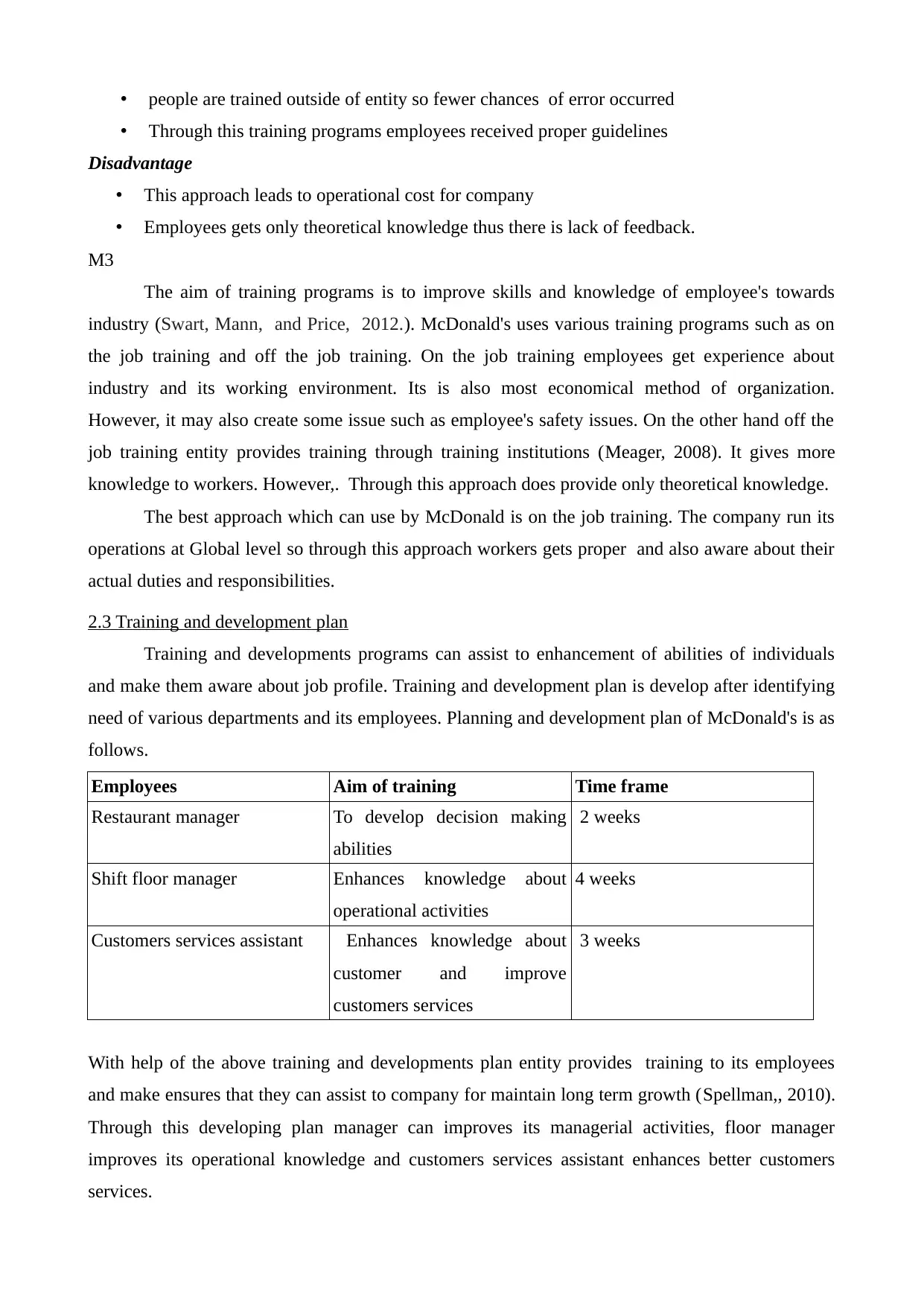
• people are trained outside of entity so fewer chances of error occurred
• Through this training programs employees received proper guidelines
Disadvantage
• This approach leads to operational cost for company
• Employees gets only theoretical knowledge thus there is lack of feedback.
M3
The aim of training programs is to improve skills and knowledge of employee's towards
industry (Swart, Mann, and Price, 2012.). McDonald's uses various training programs such as on
the job training and off the job training. On the job training employees get experience about
industry and its working environment. Its is also most economical method of organization.
However, it may also create some issue such as employee's safety issues. On the other hand off the
job training entity provides training through training institutions (Meager, 2008). It gives more
knowledge to workers. However,. Through this approach does provide only theoretical knowledge.
The best approach which can use by McDonald is on the job training. The company run its
operations at Global level so through this approach workers gets proper and also aware about their
actual duties and responsibilities.
2.3 Training and development plan
Training and developments programs can assist to enhancement of abilities of individuals
and make them aware about job profile. Training and development plan is develop after identifying
need of various departments and its employees. Planning and development plan of McDonald's is as
follows.
Employees Aim of training Time frame
Restaurant manager To develop decision making
abilities
2 weeks
Shift floor manager Enhances knowledge about
operational activities
4 weeks
Customers services assistant Enhances knowledge about
customer and improve
customers services
3 weeks
With help of the above training and developments plan entity provides training to its employees
and make ensures that they can assist to company for maintain long term growth (Spellman,, 2010).
Through this developing plan manager can improves its managerial activities, floor manager
improves its operational knowledge and customers services assistant enhances better customers
services.
• Through this training programs employees received proper guidelines
Disadvantage
• This approach leads to operational cost for company
• Employees gets only theoretical knowledge thus there is lack of feedback.
M3
The aim of training programs is to improve skills and knowledge of employee's towards
industry (Swart, Mann, and Price, 2012.). McDonald's uses various training programs such as on
the job training and off the job training. On the job training employees get experience about
industry and its working environment. Its is also most economical method of organization.
However, it may also create some issue such as employee's safety issues. On the other hand off the
job training entity provides training through training institutions (Meager, 2008). It gives more
knowledge to workers. However,. Through this approach does provide only theoretical knowledge.
The best approach which can use by McDonald is on the job training. The company run its
operations at Global level so through this approach workers gets proper and also aware about their
actual duties and responsibilities.
2.3 Training and development plan
Training and developments programs can assist to enhancement of abilities of individuals
and make them aware about job profile. Training and development plan is develop after identifying
need of various departments and its employees. Planning and development plan of McDonald's is as
follows.
Employees Aim of training Time frame
Restaurant manager To develop decision making
abilities
2 weeks
Shift floor manager Enhances knowledge about
operational activities
4 weeks
Customers services assistant Enhances knowledge about
customer and improve
customers services
3 weeks
With help of the above training and developments plan entity provides training to its employees
and make ensures that they can assist to company for maintain long term growth (Spellman,, 2010).
Through this developing plan manager can improves its managerial activities, floor manager
improves its operational knowledge and customers services assistant enhances better customers
services.
Paraphrase This Document
Need a fresh take? Get an instant paraphrase of this document with our AI Paraphraser
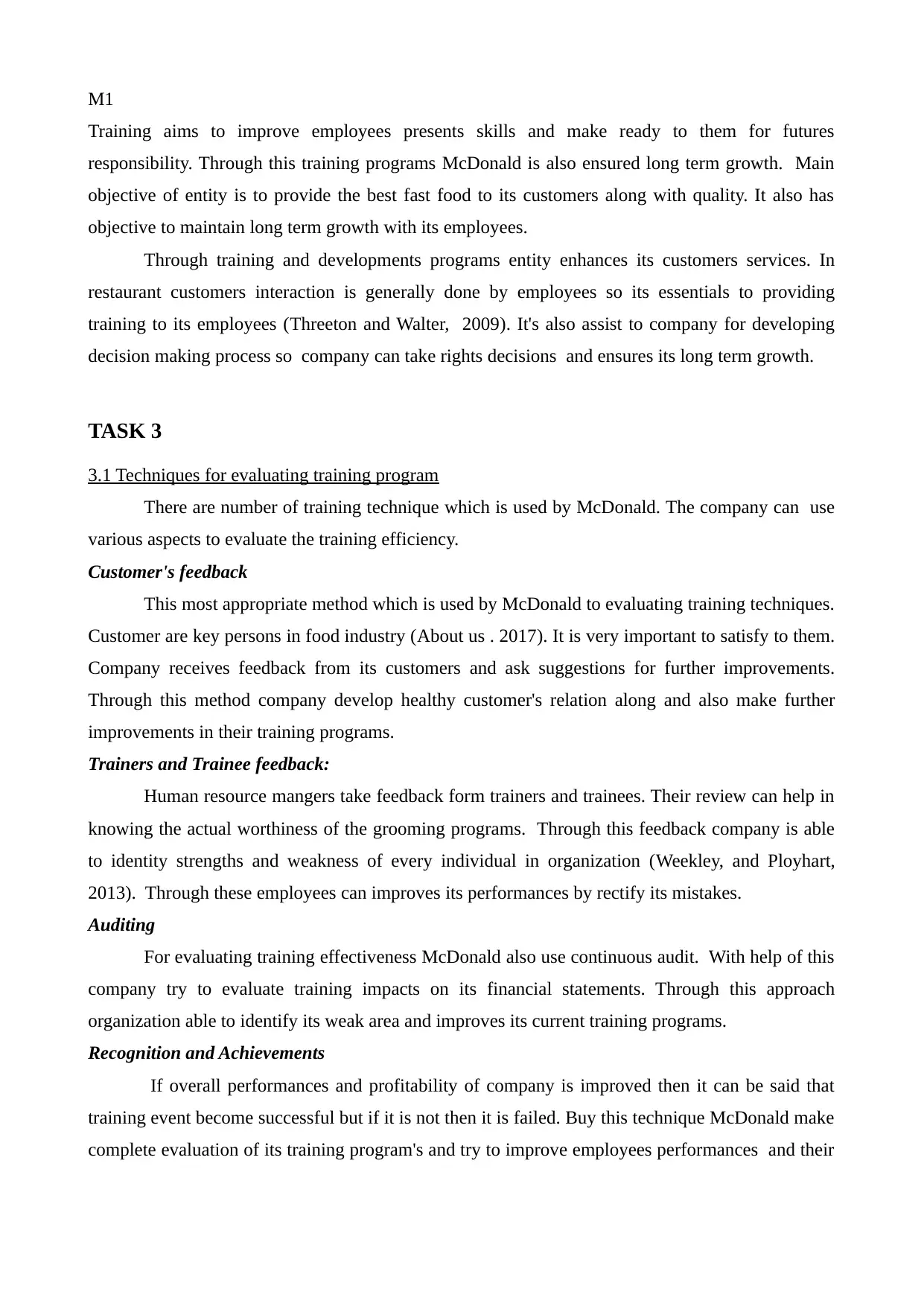
M1
Training aims to improve employees presents skills and make ready to them for futures
responsibility. Through this training programs McDonald is also ensured long term growth. Main
objective of entity is to provide the best fast food to its customers along with quality. It also has
objective to maintain long term growth with its employees.
Through training and developments programs entity enhances its customers services. In
restaurant customers interaction is generally done by employees so its essentials to providing
training to its employees (Threeton and Walter, 2009). It's also assist to company for developing
decision making process so company can take rights decisions and ensures its long term growth.
TASK 3
3.1 Techniques for evaluating training program
There are number of training technique which is used by McDonald. The company can use
various aspects to evaluate the training efficiency.
Customer's feedback
This most appropriate method which is used by McDonald to evaluating training techniques.
Customer are key persons in food industry (About us . 2017). It is very important to satisfy to them.
Company receives feedback from its customers and ask suggestions for further improvements.
Through this method company develop healthy customer's relation along and also make further
improvements in their training programs.
Trainers and Trainee feedback:
Human resource mangers take feedback form trainers and trainees. Their review can help in
knowing the actual worthiness of the grooming programs. Through this feedback company is able
to identity strengths and weakness of every individual in organization (Weekley, and Ployhart,
2013). Through these employees can improves its performances by rectify its mistakes.
Auditing
For evaluating training effectiveness McDonald also use continuous audit. With help of this
company try to evaluate training impacts on its financial statements. Through this approach
organization able to identify its weak area and improves its current training programs.
Recognition and Achievements
If overall performances and profitability of company is improved then it can be said that
training event become successful but if it is not then it is failed. Buy this technique McDonald make
complete evaluation of its training program's and try to improve employees performances and their
Training aims to improve employees presents skills and make ready to them for futures
responsibility. Through this training programs McDonald is also ensured long term growth. Main
objective of entity is to provide the best fast food to its customers along with quality. It also has
objective to maintain long term growth with its employees.
Through training and developments programs entity enhances its customers services. In
restaurant customers interaction is generally done by employees so its essentials to providing
training to its employees (Threeton and Walter, 2009). It's also assist to company for developing
decision making process so company can take rights decisions and ensures its long term growth.
TASK 3
3.1 Techniques for evaluating training program
There are number of training technique which is used by McDonald. The company can use
various aspects to evaluate the training efficiency.
Customer's feedback
This most appropriate method which is used by McDonald to evaluating training techniques.
Customer are key persons in food industry (About us . 2017). It is very important to satisfy to them.
Company receives feedback from its customers and ask suggestions for further improvements.
Through this method company develop healthy customer's relation along and also make further
improvements in their training programs.
Trainers and Trainee feedback:
Human resource mangers take feedback form trainers and trainees. Their review can help in
knowing the actual worthiness of the grooming programs. Through this feedback company is able
to identity strengths and weakness of every individual in organization (Weekley, and Ployhart,
2013). Through these employees can improves its performances by rectify its mistakes.
Auditing
For evaluating training effectiveness McDonald also use continuous audit. With help of this
company try to evaluate training impacts on its financial statements. Through this approach
organization able to identify its weak area and improves its current training programs.
Recognition and Achievements
If overall performances and profitability of company is improved then it can be said that
training event become successful but if it is not then it is failed. Buy this technique McDonald make
complete evaluation of its training program's and try to improve employees performances and their
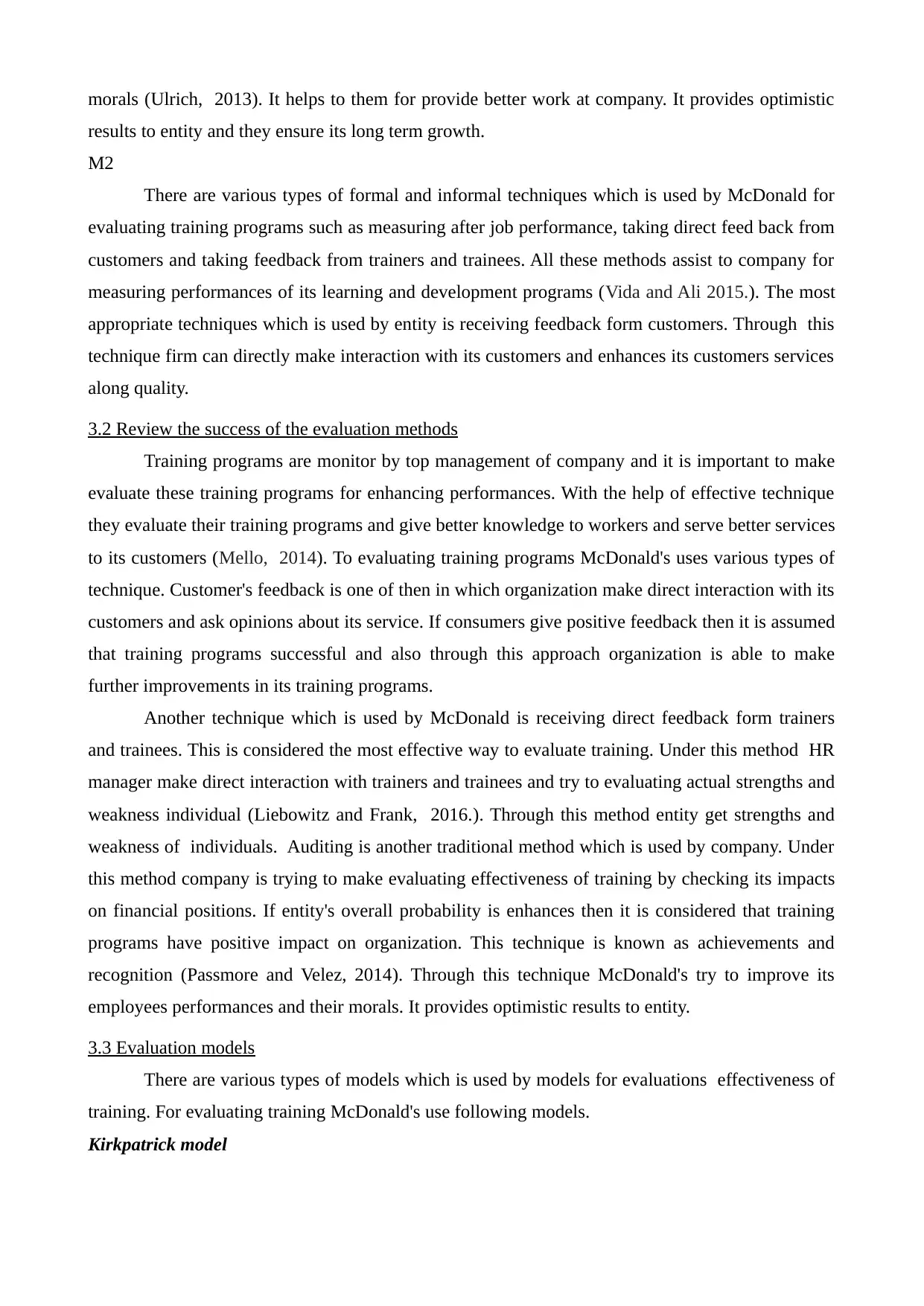
morals (Ulrich, 2013). It helps to them for provide better work at company. It provides optimistic
results to entity and they ensure its long term growth.
M2
There are various types of formal and informal techniques which is used by McDonald for
evaluating training programs such as measuring after job performance, taking direct feed back from
customers and taking feedback from trainers and trainees. All these methods assist to company for
measuring performances of its learning and development programs (Vida and Ali 2015.). The most
appropriate techniques which is used by entity is receiving feedback form customers. Through this
technique firm can directly make interaction with its customers and enhances its customers services
along quality.
3.2 Review the success of the evaluation methods
Training programs are monitor by top management of company and it is important to make
evaluate these training programs for enhancing performances. With the help of effective technique
they evaluate their training programs and give better knowledge to workers and serve better services
to its customers (Mello, 2014). To evaluating training programs McDonald's uses various types of
technique. Customer's feedback is one of then in which organization make direct interaction with its
customers and ask opinions about its service. If consumers give positive feedback then it is assumed
that training programs successful and also through this approach organization is able to make
further improvements in its training programs.
Another technique which is used by McDonald is receiving direct feedback form trainers
and trainees. This is considered the most effective way to evaluate training. Under this method HR
manager make direct interaction with trainers and trainees and try to evaluating actual strengths and
weakness individual (Liebowitz and Frank, 2016.). Through this method entity get strengths and
weakness of individuals. Auditing is another traditional method which is used by company. Under
this method company is trying to make evaluating effectiveness of training by checking its impacts
on financial positions. If entity's overall probability is enhances then it is considered that training
programs have positive impact on organization. This technique is known as achievements and
recognition (Passmore and Velez, 2014). Through this technique McDonald's try to improve its
employees performances and their morals. It provides optimistic results to entity.
3.3 Evaluation models
There are various types of models which is used by models for evaluations effectiveness of
training. For evaluating training McDonald's use following models.
Kirkpatrick model
results to entity and they ensure its long term growth.
M2
There are various types of formal and informal techniques which is used by McDonald for
evaluating training programs such as measuring after job performance, taking direct feed back from
customers and taking feedback from trainers and trainees. All these methods assist to company for
measuring performances of its learning and development programs (Vida and Ali 2015.). The most
appropriate techniques which is used by entity is receiving feedback form customers. Through this
technique firm can directly make interaction with its customers and enhances its customers services
along quality.
3.2 Review the success of the evaluation methods
Training programs are monitor by top management of company and it is important to make
evaluate these training programs for enhancing performances. With the help of effective technique
they evaluate their training programs and give better knowledge to workers and serve better services
to its customers (Mello, 2014). To evaluating training programs McDonald's uses various types of
technique. Customer's feedback is one of then in which organization make direct interaction with its
customers and ask opinions about its service. If consumers give positive feedback then it is assumed
that training programs successful and also through this approach organization is able to make
further improvements in its training programs.
Another technique which is used by McDonald is receiving direct feedback form trainers
and trainees. This is considered the most effective way to evaluate training. Under this method HR
manager make direct interaction with trainers and trainees and try to evaluating actual strengths and
weakness individual (Liebowitz and Frank, 2016.). Through this method entity get strengths and
weakness of individuals. Auditing is another traditional method which is used by company. Under
this method company is trying to make evaluating effectiveness of training by checking its impacts
on financial positions. If entity's overall probability is enhances then it is considered that training
programs have positive impact on organization. This technique is known as achievements and
recognition (Passmore and Velez, 2014). Through this technique McDonald's try to improve its
employees performances and their morals. It provides optimistic results to entity.
3.3 Evaluation models
There are various types of models which is used by models for evaluations effectiveness of
training. For evaluating training McDonald's use following models.
Kirkpatrick model
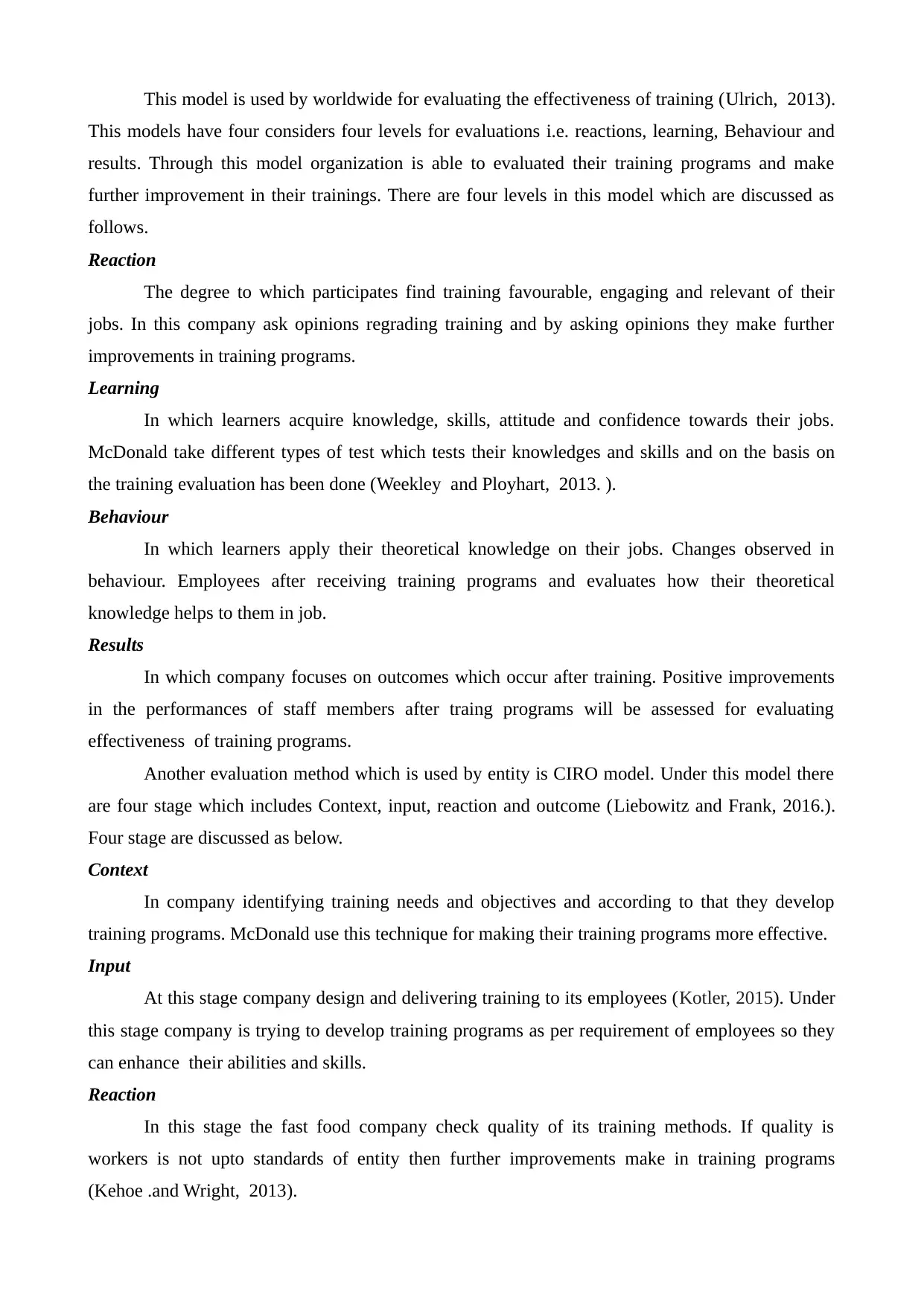
This model is used by worldwide for evaluating the effectiveness of training (Ulrich, 2013).
This models have four considers four levels for evaluations i.e. reactions, learning, Behaviour and
results. Through this model organization is able to evaluated their training programs and make
further improvement in their trainings. There are four levels in this model which are discussed as
follows.
Reaction
The degree to which participates find training favourable, engaging and relevant of their
jobs. In this company ask opinions regrading training and by asking opinions they make further
improvements in training programs.
Learning
In which learners acquire knowledge, skills, attitude and confidence towards their jobs.
McDonald take different types of test which tests their knowledges and skills and on the basis on
the training evaluation has been done (Weekley and Ployhart, 2013. ).
Behaviour
In which learners apply their theoretical knowledge on their jobs. Changes observed in
behaviour. Employees after receiving training programs and evaluates how their theoretical
knowledge helps to them in job.
Results
In which company focuses on outcomes which occur after training. Positive improvements
in the performances of staff members after traing programs will be assessed for evaluating
effectiveness of training programs.
Another evaluation method which is used by entity is CIRO model. Under this model there
are four stage which includes Context, input, reaction and outcome (Liebowitz and Frank, 2016.).
Four stage are discussed as below.
Context
In company identifying training needs and objectives and according to that they develop
training programs. McDonald use this technique for making their training programs more effective.
Input
At this stage company design and delivering training to its employees (Kotler, 2015). Under
this stage company is trying to develop training programs as per requirement of employees so they
can enhance their abilities and skills.
Reaction
In this stage the fast food company check quality of its training methods. If quality is
workers is not upto standards of entity then further improvements make in training programs
(Kehoe .and Wright, 2013).
This models have four considers four levels for evaluations i.e. reactions, learning, Behaviour and
results. Through this model organization is able to evaluated their training programs and make
further improvement in their trainings. There are four levels in this model which are discussed as
follows.
Reaction
The degree to which participates find training favourable, engaging and relevant of their
jobs. In this company ask opinions regrading training and by asking opinions they make further
improvements in training programs.
Learning
In which learners acquire knowledge, skills, attitude and confidence towards their jobs.
McDonald take different types of test which tests their knowledges and skills and on the basis on
the training evaluation has been done (Weekley and Ployhart, 2013. ).
Behaviour
In which learners apply their theoretical knowledge on their jobs. Changes observed in
behaviour. Employees after receiving training programs and evaluates how their theoretical
knowledge helps to them in job.
Results
In which company focuses on outcomes which occur after training. Positive improvements
in the performances of staff members after traing programs will be assessed for evaluating
effectiveness of training programs.
Another evaluation method which is used by entity is CIRO model. Under this model there
are four stage which includes Context, input, reaction and outcome (Liebowitz and Frank, 2016.).
Four stage are discussed as below.
Context
In company identifying training needs and objectives and according to that they develop
training programs. McDonald use this technique for making their training programs more effective.
Input
At this stage company design and delivering training to its employees (Kotler, 2015). Under
this stage company is trying to develop training programs as per requirement of employees so they
can enhance their abilities and skills.
Reaction
In this stage the fast food company check quality of its training methods. If quality is
workers is not upto standards of entity then further improvements make in training programs
(Kehoe .and Wright, 2013).
Secure Best Marks with AI Grader
Need help grading? Try our AI Grader for instant feedback on your assignments.
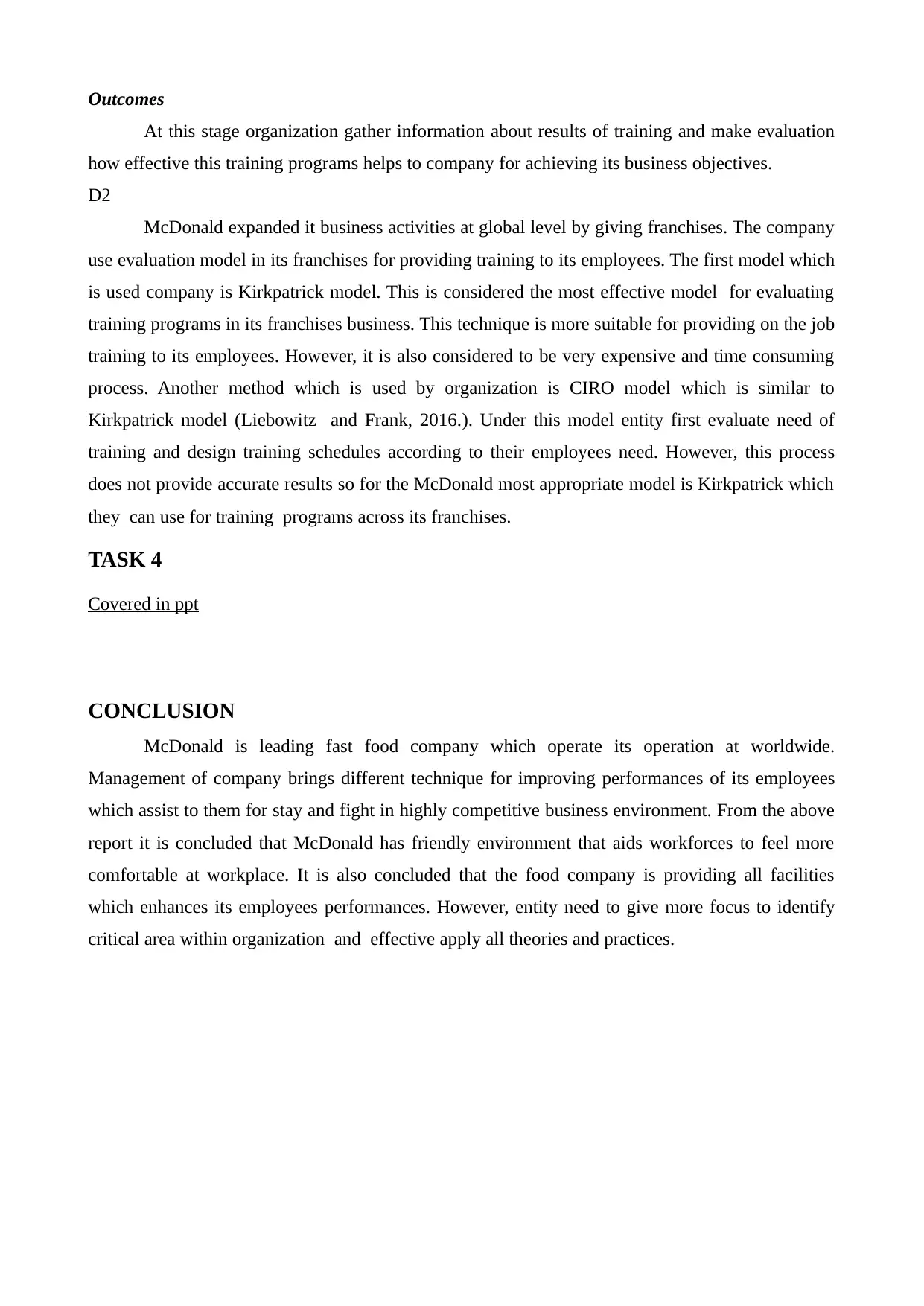
Outcomes
At this stage organization gather information about results of training and make evaluation
how effective this training programs helps to company for achieving its business objectives.
D2
McDonald expanded it business activities at global level by giving franchises. The company
use evaluation model in its franchises for providing training to its employees. The first model which
is used company is Kirkpatrick model. This is considered the most effective model for evaluating
training programs in its franchises business. This technique is more suitable for providing on the job
training to its employees. However, it is also considered to be very expensive and time consuming
process. Another method which is used by organization is CIRO model which is similar to
Kirkpatrick model (Liebowitz and Frank, 2016.). Under this model entity first evaluate need of
training and design training schedules according to their employees need. However, this process
does not provide accurate results so for the McDonald most appropriate model is Kirkpatrick which
they can use for training programs across its franchises.
TASK 4
Covered in ppt
CONCLUSION
McDonald is leading fast food company which operate its operation at worldwide.
Management of company brings different technique for improving performances of its employees
which assist to them for stay and fight in highly competitive business environment. From the above
report it is concluded that McDonald has friendly environment that aids workforces to feel more
comfortable at workplace. It is also concluded that the food company is providing all facilities
which enhances its employees performances. However, entity need to give more focus to identify
critical area within organization and effective apply all theories and practices.
At this stage organization gather information about results of training and make evaluation
how effective this training programs helps to company for achieving its business objectives.
D2
McDonald expanded it business activities at global level by giving franchises. The company
use evaluation model in its franchises for providing training to its employees. The first model which
is used company is Kirkpatrick model. This is considered the most effective model for evaluating
training programs in its franchises business. This technique is more suitable for providing on the job
training to its employees. However, it is also considered to be very expensive and time consuming
process. Another method which is used by organization is CIRO model which is similar to
Kirkpatrick model (Liebowitz and Frank, 2016.). Under this model entity first evaluate need of
training and design training schedules according to their employees need. However, this process
does not provide accurate results so for the McDonald most appropriate model is Kirkpatrick which
they can use for training programs across its franchises.
TASK 4
Covered in ppt
CONCLUSION
McDonald is leading fast food company which operate its operation at worldwide.
Management of company brings different technique for improving performances of its employees
which assist to them for stay and fight in highly competitive business environment. From the above
report it is concluded that McDonald has friendly environment that aids workforces to feel more
comfortable at workplace. It is also concluded that the food company is providing all facilities
which enhances its employees performances. However, entity need to give more focus to identify
critical area within organization and effective apply all theories and practices.
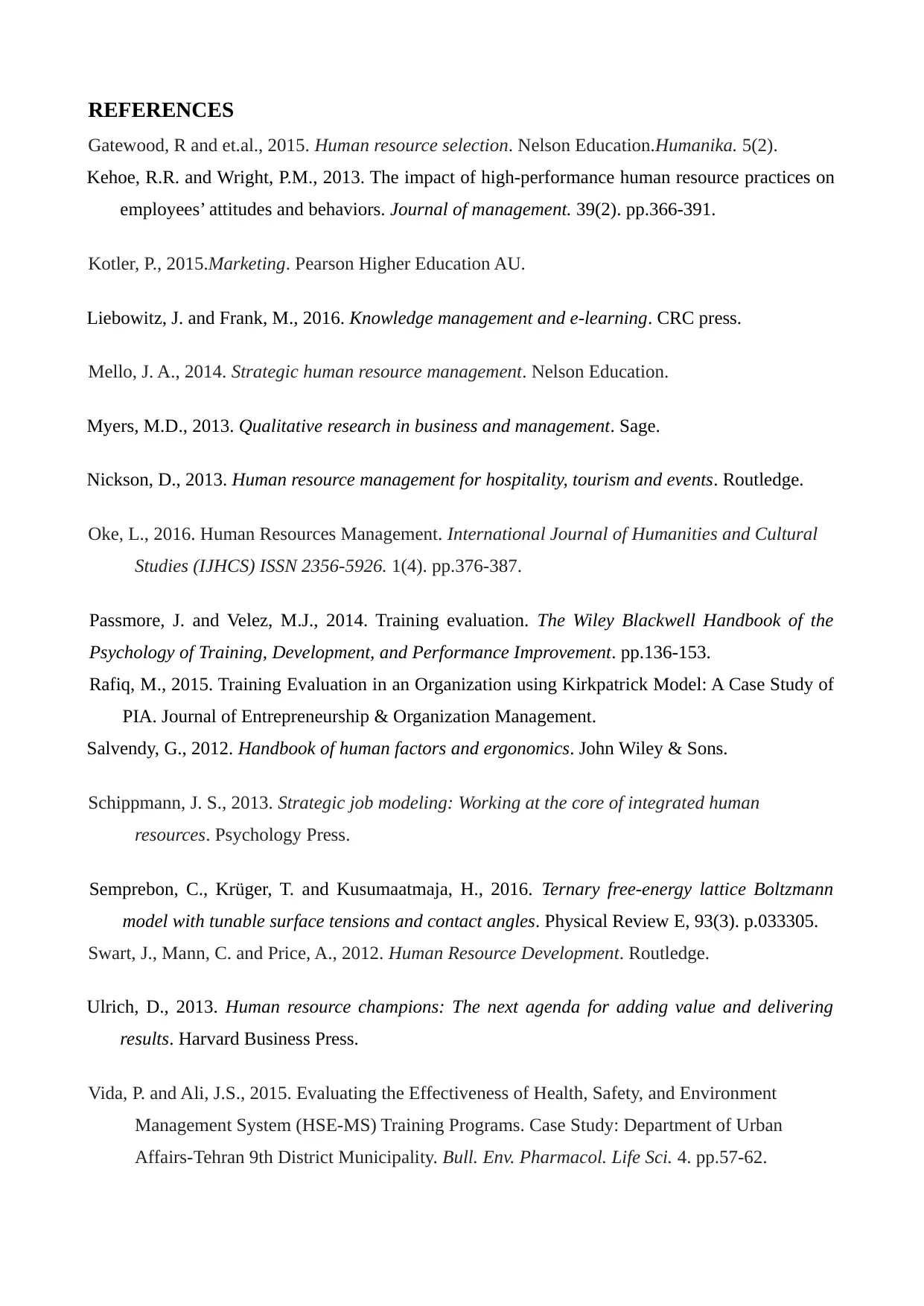
REFERENCES
Gatewood, R and et.al., 2015. Human resource selection. Nelson Education.Humanika. 5(2).
Kehoe, R.R. and Wright, P.M., 2013. The impact of high-performance human resource practices on
employees’ attitudes and behaviors. Journal of management. 39(2). pp.366-391.
Kotler, P., 2015.Marketing. Pearson Higher Education AU.
Liebowitz, J. and Frank, M., 2016. Knowledge management and e-learning. CRC press.
Mello, J. A., 2014. Strategic human resource management. Nelson Education.
Myers, M.D., 2013. Qualitative research in business and management. Sage.
Nickson, D., 2013. Human resource management for hospitality, tourism and events. Routledge.
Oke, L., 2016. Human Resources Management. International Journal of Humanities and Cultural
Studies (IJHCS) ISSN 2356-5926. 1(4). pp.376-387.
Passmore, J. and Velez, M.J., 2014. Training evaluation. The Wiley Blackwell Handbook of the
Psychology of Training, Development, and Performance Improvement. pp.136-153.
Rafiq, M., 2015. Training Evaluation in an Organization using Kirkpatrick Model: A Case Study of
PIA. Journal of Entrepreneurship & Organization Management.
Salvendy, G., 2012. Handbook of human factors and ergonomics. John Wiley & Sons.
Schippmann, J. S., 2013. Strategic job modeling: Working at the core of integrated human
resources. Psychology Press.
Semprebon, C., Krüger, T. and Kusumaatmaja, H., 2016. Ternary free-energy lattice Boltzmann
model with tunable surface tensions and contact angles. Physical Review E, 93(3). p.033305.
Swart, J., Mann, C. and Price, A., 2012. Human Resource Development. Routledge.
Ulrich, D., 2013. Human resource champions: The next agenda for adding value and delivering
results. Harvard Business Press.
Vida, P. and Ali, J.S., 2015. Evaluating the Effectiveness of Health, Safety, and Environment
Management System (HSE-MS) Training Programs. Case Study: Department of Urban
Affairs-Tehran 9th District Municipality. Bull. Env. Pharmacol. Life Sci. 4. pp.57-62.
Gatewood, R and et.al., 2015. Human resource selection. Nelson Education.Humanika. 5(2).
Kehoe, R.R. and Wright, P.M., 2013. The impact of high-performance human resource practices on
employees’ attitudes and behaviors. Journal of management. 39(2). pp.366-391.
Kotler, P., 2015.Marketing. Pearson Higher Education AU.
Liebowitz, J. and Frank, M., 2016. Knowledge management and e-learning. CRC press.
Mello, J. A., 2014. Strategic human resource management. Nelson Education.
Myers, M.D., 2013. Qualitative research in business and management. Sage.
Nickson, D., 2013. Human resource management for hospitality, tourism and events. Routledge.
Oke, L., 2016. Human Resources Management. International Journal of Humanities and Cultural
Studies (IJHCS) ISSN 2356-5926. 1(4). pp.376-387.
Passmore, J. and Velez, M.J., 2014. Training evaluation. The Wiley Blackwell Handbook of the
Psychology of Training, Development, and Performance Improvement. pp.136-153.
Rafiq, M., 2015. Training Evaluation in an Organization using Kirkpatrick Model: A Case Study of
PIA. Journal of Entrepreneurship & Organization Management.
Salvendy, G., 2012. Handbook of human factors and ergonomics. John Wiley & Sons.
Schippmann, J. S., 2013. Strategic job modeling: Working at the core of integrated human
resources. Psychology Press.
Semprebon, C., Krüger, T. and Kusumaatmaja, H., 2016. Ternary free-energy lattice Boltzmann
model with tunable surface tensions and contact angles. Physical Review E, 93(3). p.033305.
Swart, J., Mann, C. and Price, A., 2012. Human Resource Development. Routledge.
Ulrich, D., 2013. Human resource champions: The next agenda for adding value and delivering
results. Harvard Business Press.
Vida, P. and Ali, J.S., 2015. Evaluating the Effectiveness of Health, Safety, and Environment
Management System (HSE-MS) Training Programs. Case Study: Department of Urban
Affairs-Tehran 9th District Municipality. Bull. Env. Pharmacol. Life Sci. 4. pp.57-62.
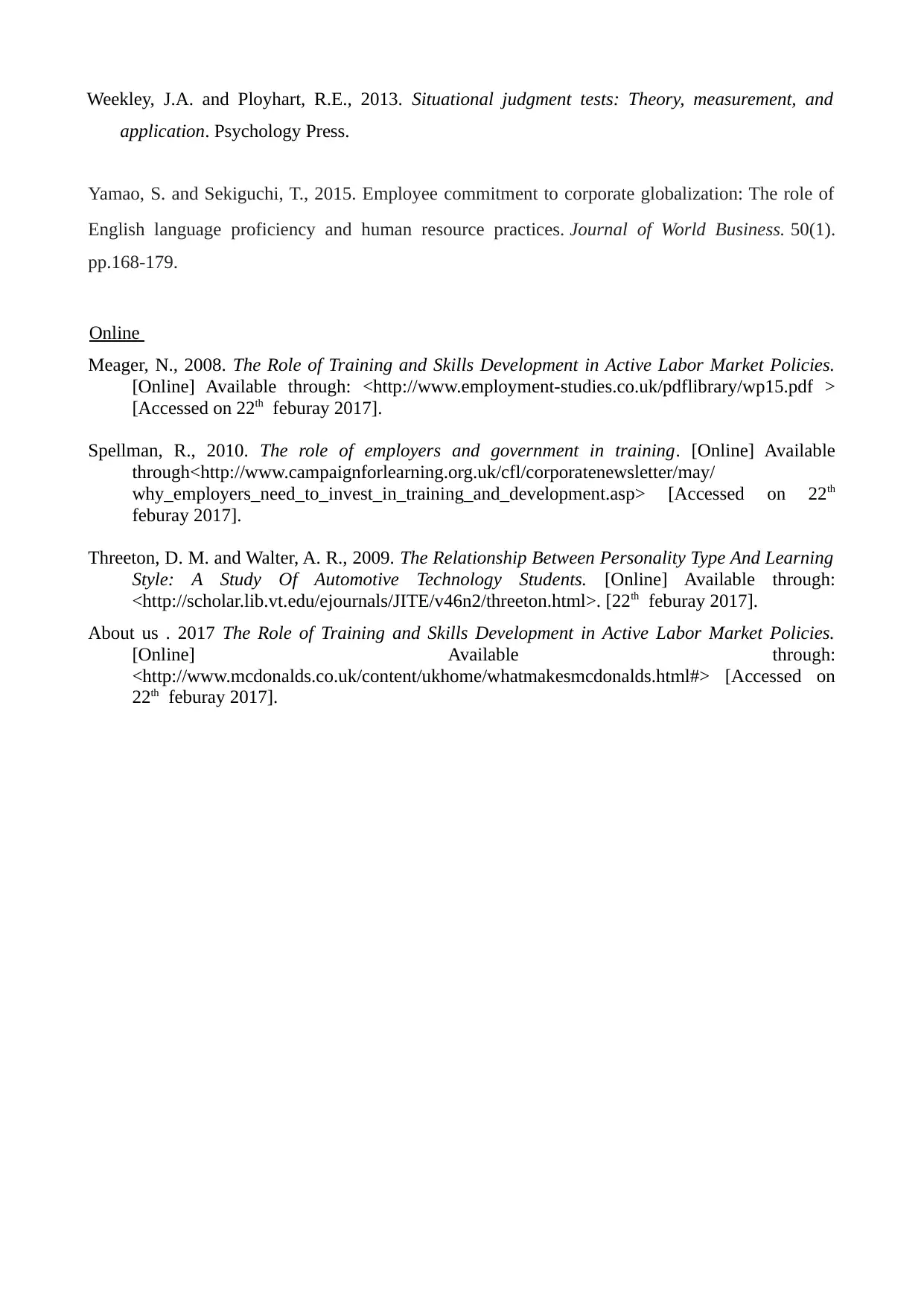
Weekley, J.A. and Ployhart, R.E., 2013. Situational judgment tests: Theory, measurement, and
application. Psychology Press.
Yamao, S. and Sekiguchi, T., 2015. Employee commitment to corporate globalization: The role of
English language proficiency and human resource practices. Journal of World Business. 50(1).
pp.168-179.
Online
Meager, N., 2008. The Role of Training and Skills Development in Active Labor Market Policies.
[Online] Available through: <http://www.employment-studies.co.uk/pdflibrary/wp15.pdf >
[Accessed on 22th feburay 2017].
Spellman, R., 2010. The role of employers and government in training. [Online] Available
through<http://www.campaignforlearning.org.uk/cfl/corporatenewsletter/may/
why_employers_need_to_invest_in_training_and_development.asp> [Accessed on 22th
feburay 2017].
Threeton, D. M. and Walter, A. R., 2009. The Relationship Between Personality Type And Learning
Style: A Study Of Automotive Technology Students. [Online] Available through:
<http://scholar.lib.vt.edu/ejournals/JITE/v46n2/threeton.html>. [22th feburay 2017].
About us . 2017 The Role of Training and Skills Development in Active Labor Market Policies.
[Online] Available through:
<http://www.mcdonalds.co.uk/content/ukhome/whatmakesmcdonalds.html#> [Accessed on
22th feburay 2017].
application. Psychology Press.
Yamao, S. and Sekiguchi, T., 2015. Employee commitment to corporate globalization: The role of
English language proficiency and human resource practices. Journal of World Business. 50(1).
pp.168-179.
Online
Meager, N., 2008. The Role of Training and Skills Development in Active Labor Market Policies.
[Online] Available through: <http://www.employment-studies.co.uk/pdflibrary/wp15.pdf >
[Accessed on 22th feburay 2017].
Spellman, R., 2010. The role of employers and government in training. [Online] Available
through<http://www.campaignforlearning.org.uk/cfl/corporatenewsletter/may/
why_employers_need_to_invest_in_training_and_development.asp> [Accessed on 22th
feburay 2017].
Threeton, D. M. and Walter, A. R., 2009. The Relationship Between Personality Type And Learning
Style: A Study Of Automotive Technology Students. [Online] Available through:
<http://scholar.lib.vt.edu/ejournals/JITE/v46n2/threeton.html>. [22th feburay 2017].
About us . 2017 The Role of Training and Skills Development in Active Labor Market Policies.
[Online] Available through:
<http://www.mcdonalds.co.uk/content/ukhome/whatmakesmcdonalds.html#> [Accessed on
22th feburay 2017].
1 out of 13
Related Documents
Your All-in-One AI-Powered Toolkit for Academic Success.
+13062052269
info@desklib.com
Available 24*7 on WhatsApp / Email
![[object Object]](/_next/static/media/star-bottom.7253800d.svg)
Unlock your academic potential
© 2024 | Zucol Services PVT LTD | All rights reserved.





